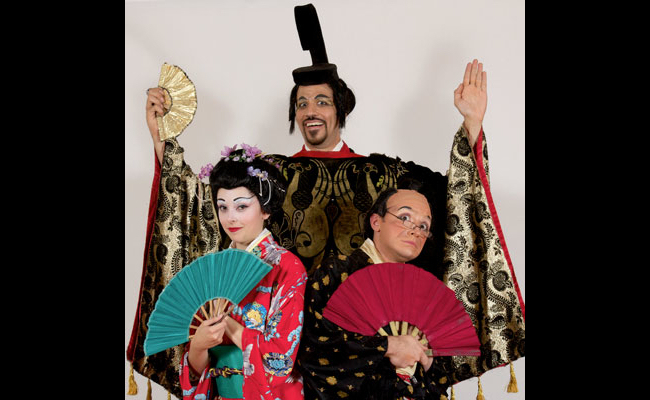
Having learned nothing apparently from last year’s “Mikado” fiasco in Seattle, the New York Gilbert & Sullivan Players (NYGASP) — a more than 30-year-old professional repertory company devoted to staging performances of Gilbert & Sullivan works — announced this year that “The Mikado” would be included in their 2015-2016 season. Written in 1885, “The Mikado”‘s opening run was one of the longest of its time, and is considered one of the most popular works in the Gilbert & Sullivan repertoire. “The Mikado” is also highly offensive: intended to satirize British politics, the play is set in an Orientalist fantasy of Japan, and is typically staged by White actors in costumes and makeup designed to make them appear Asian; or, more colloquially, in “yellowface“.
The NYGASP’s show is no exception: judging by images from its 2010 and 2013 performances (see featured image above), NYGASP’s performance is replete with non-Asian actors donning black wigs, kimonos, and face paint. This year, NYGASP’s version of “The Mikado” is scheduled to appear at the Skirball Center for the Performing Arts at NYU December 26-January 2.
In Seattle last year, members of the Asian American community spoke out against the Seattle Gilbert & Sullivan Society’s scheduled performance, sparking a heated online and in-person discussion over racism and diversity in the performing arts. Although last year’s performance in Seattle continued with actors in yellowface despite the outcry of the Asian American community, both the company and the theatre were forced to confront the implications of the show for Asian American audience members, who must endure the appropriation of our racial and cultural identities as farcical comedy and caricatured costume.
I get that lots of people who like Gilbert & Sullivan enjoy “The Mikado”. But, those same people must also recognize that their enjoyment of “The Mikado’s” invoking of late-nineteenth century Japonism (a fancy euphemism for base Orientalism) is archaic, and clearly racist by today’s political and cultural standards.
Supporters of “The Mikado” in Seattle made several defenses of the play’s Orientalism and yellowface last year; many of those same defensive arguments have reappeared this week as the Asian American community turned its attention to NYGASP’s “The Mikado” performance.
Defenders of “The Mikado” typically start with the fact that librettist W.S. Gilbert chose to situate “The Mikado” in a fictional version of Japan in order to better satirize British high society. “The Mikado”‘s Japan, they argue, is not intended to be read as a reflection of the real Japan, and therefore permits, they contend, the play’s use of racialized caricature. Yet, in the same breath, they will also argue that steps have been taken to ensure that their props and makeup appear to be authentically Japanese. For example, in a statement released earlier this week (and since deleted from Facebook; mirrored here), NYGASP cited their efforts to consult with a real Japanese American person on the costume and set design of earlier performances. These two arguments contradict one another: “The Mikado”‘s Japan cannot simultaneously be intended to be read as a totally imaginary, Japanese-inspired place that isn’t actually Japan, while also being — in the eyes of the players — as “authentically” Japanese as possible. Either “The Mikado” is intended to be read as Japan (which, unlike other Gilbert & Sullivan settings, is an actual place), or it is not. Gilbert & Sullivan supporters cannot have it both ways.
Regardless of whether or not “The Mikado” is intended to be Japanese (i.e. actually Japan) or Japonaise (i.e. a fictionalized and Orientalized Japan that exists only within the realm of Western imagination), it remains true that “The Mikado” stagings typically involve the use of makeup and costume to transform the race of its actors, with the intention of separating players and play from the familiarity of racial Whiteness and British culture so that the play might comment on the latter. We can call this satire if we’d like, but if so, this is satire that defenders of “The Mikado” must therefore also agree relies upon Orientalism, racial drag, and the implicit assumption that Asians are part of the “Other”. If so, why must Asian and Asian American audiences tolerate it? Charlie Hebdo notwithstanding, the intent to accomplish political satire is not itself a justification for insensitive and oftentimes racist works; no moreso than the pain of being called a slur is lessened by someone saying they “meant the slur in a nice way”. The why of actors in yellowface does not mitigate the racism of the yellowface.
Lastly, let us also be clear on one thing: this is yellowface. In Seattle last year, defenders argued that wigs did not constitute makeup, and therefore no yellowface was used. A similar argument was made by NYGASP to Playbill this year. This defense is grounded in an arbitrarily rigid definition of blackface, brownface, and yellowface that is focused only on the actual application of pigment to the face, while ignoring the larger picture of why such racial makeup is problematic. (Never mind, of course, that black wigs have always been part of the ritual of yellowface.) Blackening one’s face with shoe polish is not offensive because shoe polish itself disturbs one’s sensibilities; it is offensive because yellowface, blackface, and brownface employ physical and behavioural stereotypes to appropriate the race of another group for a performance that “Other-izes” and mocks those same groups. To focus on skin darkening agents as the primary source of blackface, brownface, or yellowface’s trouble — while giving a pass to the use of wigs and costumes — is to (deliberately?) miss that larger point: any use of physical props to communicate an alteration of an actor’s race exists within this legacy of yellowface, blackface, and brownface. NYGASP’s actors need not use actual face makeup to be wearing yellowface. In NYGASP’s performance of “The Mikado” (as with most performances), the wigs and costuming are serving as yellowface signifiers.
As Erin Quill notes for Playbill, no one in the Asian American community discounts that Gilbert & Sullivan is a “staple of the G&S canon, nor that the music is lovely”. But we must also recognize that “The Mikado”‘s Japanese (or Japonaise) setting is an archaic throwback to the racial sensibilities of late nineteenth century Britain — not exactly a time known for its racial sensitivity towards Black or Asian people. Unapologetic revivals of “The Mikado” choose to ignore the outcry of the contemporary Asian American community, and demand instead that an entire group of people defer silently to a theatrical celebration of a century-old racial politic, when Asia was obsessed over as a place of delightful fantasy while Asian people were deplored and exploited as immoral, unintelligent and sub-human, and likely even excluded from sitting in the audience of original “The Mikado” performances.
Last year, Jeff Yang argued that yellowface stagings of “The Mikado” must end. I agree. If “The Mikado”‘s intent is to satirize British high society, it does not require yellowface. That “The Mikado” traditionally employs such racial drag (and other artifacts of Orientalism) argues only that the play is grounded in a tradition of racism, but not that this tradition is necessary. As already discussed, an objective consideration of “The Mikado” painfully reveals the contradiction of its Japanese vs Japonaise setting: with regard to how it treats Japan (as fiction or reality), it is a hot mess. For example, “Titipu”, “Yum Yum” and “Nanki-poo” are not Japanese (or even Japanese-sounding) names. Thus, as written, no part of “The Mikado” requires it to be set in a fictionalized Japan with actors in yellowface. Gilbert & Sullivan repertory companies cling to “The Mikado’s” Orientalized racial costuming out of habit, nothing more. We can do better.
It has been over a century since “The Mikado” first opened on the stage of the Savoy Theatre. In that time, society has come a long way in its treatment of non-White people. Brazen cultural throwbacks to a time before we respected the humanity of Asians (or other people of colour) have no place in today’s world, and certainly not without political consideration of those whose racial and cultural identities are targeted by the performance. Indeed, several lyrics of “The Mikado” have already been modified over time: instances of the n-word were long removed, and it is tradition among many Gilbert & Sullivan companies for the lyrics of one song (“I’ve Got A Little List”) to be rewritten with the addition of contemporary references (video). This indicates that Gillbert’s original text is not considered sacrosanct; instead, there is already precedence for altering the play to reflect modern sensibilities.
We do not live in 1885 Britain, when those who would have attended “The Mikado” were mostly upper-class British Whites, and when Asian people were actively excluded from participating in Western society as equals. “The Mikado”, as originally written and performed, is part of that archaic racial sensibility, but it doesn’t need to be. The Gilbert & Sullivan community is at a crossroads: they must decide whether or not it’s finally time to acknowledge that unlike the late 1800’s, today’s audience members are not solely members of Britain’s upper-class White elite, and today will include people of colour. Today’s Gilbert & Sullivan players must finally decide if a rigid adherence to theatrical traditionalism is worth the ongoing racial disrespect of that non-White audience.
I believe it’s not.
No one is talking about banning performances of “The Mikado”. But, two centuries after its opening performance, I believe it’s time to reinvent “The Mikado” in a way that reflects tolerance of today’s racially plural society. I believe it’s finally time to invite non-White people into the audiences of Gilbert & Sullivan performances by correcting the ways that the original works appealed to an audience comprised of non-Asians at our racial expense. I believe it’s time to put the wigs, makeup and kimonos away, and find a way to perform “The Mikado” without the racism.
Breaking Update: After a week of heated backlash, NYGASP announced this morning (as I was finishing writing this post) that it has canceled its December 26 – January 2 production of “The Mikado” scheduled at the Skirball Performing Arts Center, and will instead be performing “The Pirates of Penzance” for those scheduled shows. It’s original statement defending its “Mikado” production has been erased from Facebook, and interestingly many references to contemporary productions of “The Mikado” (including play synopses and production photos) and has been scrubbed from its website. Victory, by way of NYGASP’s attempting to rewrite history, I guess?
Please note, however, that NYGASP’s current production of “The Mikado” is still scheduled to go on this week September 21st and 23rd at the Lenfest Center for the Performing Arts at Washington and Lee University in Florida.
To follow developments in this story, you are invited to join the “The Mikado is Stupid” Facebook group.


